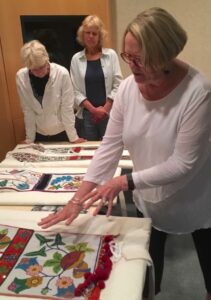
By Sonjie Johnson
An apt description of Marcia Anderson’s journey, and it’s far from over. A published author and retired collections curator for the Minnesota History Center, Marcia moved to Como Park in 1987, partly because of its nature-centered culture and community.
“Billie Pierce, my Girl Scout leader,” she said, when I asked about the influences that inspired her life and career. “I loved nature, and I was a curious kid.” Marcia grew up in Spokane, Washington, and got an MA in museum studies/anthropology from the University of Arizona. It was there where she became first interested in indigenous arts and culture. Arizona has more tribal land than any other state, and native arts and crafts were plentiful. She found that tribal histories written by European authors rarely mentioned women’s artistic contributions, much of them functional in nature.

Marcia became the collections curator at the Minnesota Historical Society’s History Center in 1981. It was early days there when she opened a storage box to find “beautiful beaded bags, folded and piled haphazardly on top of one another.”* They were bandolier bags, or gashkibidaagan – decorative, semi-functional art created initially by Native Americans in the mid to late 1800s.
As she found more bags, Marcia learned that they were made well into the 1900s, by Ojibwe women from the Great Lakes Region. Many questions about the bags remained. What was their history? What was their significance and how did these bags end up in storage boxes at the History Center? Who were the bead artists?
Over the next 32 years, Marcia researched archives and museums, met many times with tribal leaders and artists themselves, in order discover other bags, and record the history of the bandolier bags and others similar to the ones that she had found in storage. Her work is beautifully documented in A Bag worth a Pony: the art of the Ojibwe Bandolier Bag, published in 2017. A labor of dedication and love, the narrative and pictorial record took six years post-retirement to compile.

And yes, the title is accurate – it was not uncommon for other native tribes to trade a pony for a bag – a bag that does not fit the typical definition. The Ojibwe cross-body bags were also ornaments, symbols of status and pride for the wearer. The book is available on Amazon, and the MNHS Press, and at the Twin Cities Public Libraries. It is a fascinating and educational read. Marcia has also contributed essays on the arts and
crafts movement in Minnesota.
As a material culture specialist, and a historian particularly interested in women’s stories, Marcia is a dedicated volunteer in Como Park activities and throughout the Twin Cities. She believes that those values were instilled and cemented by her Girl Scout experiences. Marcia’s current activities include working as a Volunteer at Como Conservatory and Charlotte Partridge Ordway Japanese Garden, serving on the Como Neighborhood History Project committee, and on the American Swedish Institute Board of Trustees.
*A Bag Worth a Pony: the art of the Ojibwe Bandolier Bag.
Do you know some interesting history about your home, your neighbor or about the Como neighborhood? Anyone is welcome to do an interview, share historic photos or do a write up for the Know Your Como segment of our newsletter! For more information on how to submit go to our Know Your Como page.
